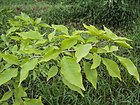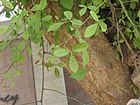Note: This is a project under development. The articles on this wiki are just being initiated and broadly incomplete. You can Help creating new pages.
Difference between revisions of "Aegle marmelos - Bilva"
(→Karma) |
|||
| Line 1: | Line 1: | ||
| − | {{ | + | [[File:Aegle marmelos flower 02.JPG|thumb|right|''Bilva'']] |
| + | '''Bilva''' consists of pulp of entire, unripe or half ripe fruits of Aegle marmelos Carr. (Fam. Rutaceae), a tree, attaining a height of 12 m growing wild and also cultivated throughout the country, rind of fruit is removed and pulp is bruised and dried<ref name="AYURVEDIC PHARMACOPOEIA OF INDIA"/> | ||
| + | |||
| + | ==Uses== | ||
| + | {{Uses|Blisters in mouths}}, {{Uses|mouth sores}}, {{Uses|bleeding piles}}, {{Uses|leucorrhoea}}, {{Uses|Mild diabetes}}, {{Uses|Cough}}, {{Uses|physical weakness}}, {{Uses|ulcer}}, {{Uses|Urinary trouble}}, {{Uses|snakebite}}, {{Uses|infection in intestine}}. | ||
| + | |||
| + | ==Parts Used== | ||
| + | {{Parts Used|Seeds}}, {{Parts Used|stem}}, {{Parts Used|leaves}}, {{Parts Used|Root}}. | ||
| − | + | ==Chemical Composition== | |
| + | Marmalosin, tannins, mucilage, fatty oil and sugar.<ref name="chemical composition"/> | ||
==Common names== | ==Common names== | ||
{{Common names|kn=Bilva|ml=Koovalam|sa=Shreephala|ta=Vilvam|te=Maredu|hi=Bela, Sriphal, Bel|en=Bengal Quince, Bael fruit|mr=Bel, Baela|gu=Bill, Bilum, Bilvaphal|pa=Bil|ks=Bel}} | {{Common names|kn=Bilva|ml=Koovalam|sa=Shreephala|ta=Vilvam|te=Maredu|hi=Bela, Sriphal, Bel|en=Bengal Quince, Bael fruit|mr=Bel, Baela|gu=Bill, Bilum, Bilvaphal|pa=Bil|ks=Bel}} | ||
| − | |||
| − | |||
| − | |||
==Properties== | ==Properties== | ||
| Line 22: | Line 27: | ||
===Karma=== | ===Karma=== | ||
Balya, [[Deepana]], Grahya, Paacana | Balya, [[Deepana]], Grahya, Paacana | ||
| + | ===Prabhava=== | ||
| + | |||
| + | ==Habit== | ||
| + | {{Habit|}} | ||
| + | |||
| + | ==Identification== | ||
| + | ===Leaf=== | ||
| + | {{Leaf|Paripinnate|Oblong|Leaf Arrangementis Alternate-spiral}}<ref name="Leaf"/> | ||
| + | |||
| + | ===Flower=== | ||
| + | {{Flower|Unisexual|2-4cm long|pink||Flowering throughout the year and In terminal and/or axillary pseudoracemes}} | ||
| + | |||
| + | ===Fruit=== | ||
| + | {{Fruit|oblong pod|Thinly septate, pilose, wrinkled|||seeds upto 5|Fruiting throughout the year}} | ||
| + | |||
| + | ===Other features=== | ||
| + | |||
| + | ==List of Ayurvedic medicine in which the herb is used== | ||
| + | |||
| + | ==Where to get the saplings== | ||
| + | |||
| + | ==Mode of Propagation== | ||
| + | {{Propagation|Seeds}} | ||
| + | |||
| + | ==How to plant/cultivate== | ||
| + | <ref name="How to plant/cultivate"/> | ||
| + | |||
| + | ==Commonly seen growing in areas== | ||
| + | {{Commonly seen|tropical}}, {{Commonly seen|Caribbean Islands}}, {{Commonly seen|subtropical}}, {{Commonly seen|pinelands}}, {{Commonly seen|hammocks}}. | ||
| + | |||
| + | ==Photo Gallery== | ||
| + | <gallery class="left" caption="" widths="140px" heights="140px"> | ||
| + | Aegle marmelos flower 02.JPG | ||
| + | Aegle marmelos flowers 03.JPG | ||
| + | Aegle marmelos 03.JPG | ||
| + | Aegle marmelos bark 01.JPG | ||
| + | Aegle marmelos (L.)Correa.jpg | ||
| − | + | ||
| + | </gallery> | ||
==References== | ==References== | ||
| − | |||
| + | <references> | ||
| + | <ref name="chemical composition">["Chemistry"]</ref> | ||
| + | <ref name="Leaf">[ "Morphology"]</ref> | ||
| + | <ref name="How to plant/cultivate">[ "Cultivation detail"]</ref> | ||
<ref name="AYURVEDIC PHARMACOPOEIA OF INDIA">THE AYURVEDIC PHARMACOPOEIA OF INDIA, PART-I, VOLUME-1, page no 35.</ref> | <ref name="AYURVEDIC PHARMACOPOEIA OF INDIA">THE AYURVEDIC PHARMACOPOEIA OF INDIA, PART-I, VOLUME-1, page no 35.</ref> | ||
| − | |||
</references> | </references> | ||
| − | == | + | ==External Links== |
| + | * [http://www.ayurveda.hu/api/API-Vol-1.pdf THE AYURVEDIC PHARMACOPOEIA OF INDIA] | ||
| − | + | [[Category:Herbs]] | |
| − | |||
| − | [[Category: | ||
Revision as of 18:19, 24 September 2018
Bilva consists of pulp of entire, unripe or half ripe fruits of Aegle marmelos Carr. (Fam. Rutaceae), a tree, attaining a height of 12 m growing wild and also cultivated throughout the country, rind of fruit is removed and pulp is bruised and dried[1]
Contents
- 1 Uses
- 2 Parts Used
- 3 Chemical Composition
- 4 Common names
- 5 Properties
- 6 Habit
- 7 Identification
- 8 List of Ayurvedic medicine in which the herb is used
- 9 Where to get the saplings
- 10 Mode of Propagation
- 11 How to plant/cultivate
- 12 Commonly seen growing in areas
- 13 Photo Gallery
- 14 References
- 15 External Links
Uses
Blisters in mouths, mouth sores, bleeding piles, leucorrhoea, Mild diabetes, Cough, physical weakness, ulcer, Urinary trouble, snakebite, infection in intestine.
Parts Used
Chemical Composition
Marmalosin, tannins, mucilage, fatty oil and sugar.[2]
Common names
| Language | Common name |
|---|---|
| Kannada | Bilva |
| Hindi | Bela, Sriphal, Bel |
| Malayalam | Koovalam |
| Tamil | Vilvam |
| Telugu | Maredu |
| Marathi | Bel, Baela |
| Gujarathi | Bill, Bilum, Bilvaphal |
| Punjabi | Bil |
| Kashmiri | Bel |
| Sanskrit | Shreephala |
| English | Bengal Quince, Bael fruit |
Properties
Reference: Dravya - Substance, Rasa - Taste, Guna - Qualities, Veerya - Potency, Vipaka - Post-digesion effect, Karma - Pharmacological activity, Prabhava - Therepeutics.
Dravya
Rasa
Katu (Pungent), Tikta, Kashaya
Guna
Laghu (Light), Ruksha (Dry)
Veerya
Ushna (heat)
Vipaka
Katu (Pungent)
Karma
Balya, Deepana, Grahya, Paacana
Prabhava
Habit
[[:Category:Habit - |]]
Identification
Leaf
| Kind | Shape | Feature |
|---|---|---|
| Paripinnate | Oblong | Leaf Arrangementis Alternate-spiral |
Flower
| Type | Size | Color and composition | Stamen | More information |
|---|---|---|---|---|
| Unisexual | 2-4cm long | pink | Flowering throughout the year and In terminal and/or axillary pseudoracemes |
Fruit
| Type | Size | Mass | Appearance | Seeds | More information |
|---|---|---|---|---|---|
| oblong pod | Thinly septate, pilose, wrinkled | seeds upto 5 | Fruiting throughout the year |
Other features
List of Ayurvedic medicine in which the herb is used
Where to get the saplings
Mode of Propagation
How to plant/cultivate
Commonly seen growing in areas
tropical, Caribbean Islands, subtropical, pinelands, hammocks.
Photo Gallery
References
External Links
- Ayurvedic Herbs known to be helpful to treat Blisters in mouths
- Ayurvedic Herbs known to be helpful to treat mouth sores
- Ayurvedic Herbs known to be helpful to treat bleeding piles
- Ayurvedic Herbs known to be helpful to treat leucorrhoea
- Ayurvedic Herbs known to be helpful to treat Mild diabetes
- Ayurvedic Herbs known to be helpful to treat Cough
- Ayurvedic Herbs known to be helpful to treat physical weakness
- Ayurvedic Herbs known to be helpful to treat ulcer
- Ayurvedic Herbs known to be helpful to treat Urinary trouble
- Ayurvedic Herbs known to be helpful to treat snakebite
- Ayurvedic Herbs known to be helpful to treat infection in intestine
- Herbs with Seeds used in medicine
- Herbs with stem used in medicine
- Herbs with leaves used in medicine
- Herbs with Root used in medicine
- Herbs with common name in Kannada
- Herbs with common name in Hindi
- Herbs with common name in Malayalam
- Herbs with common name in Tamil
- Herbs with common name in Telugu
- Herbs with common name in Marathi
- Herbs with common name in Gujarathi
- Herbs with common name in Punjabi
- Herbs with common name in Kashmiri
- Herbs with common name in Sanskrit
- Herbs with common name in English
- Habit -
- Index of Plants which can be propagated by Seeds
- Herbs that are commonly seen in the region of tropical
- Herbs that are commonly seen in the region of Caribbean Islands
- Herbs that are commonly seen in the region of subtropical
- Herbs that are commonly seen in the region of pinelands
- Herbs that are commonly seen in the region of hammocks
- Herbs





